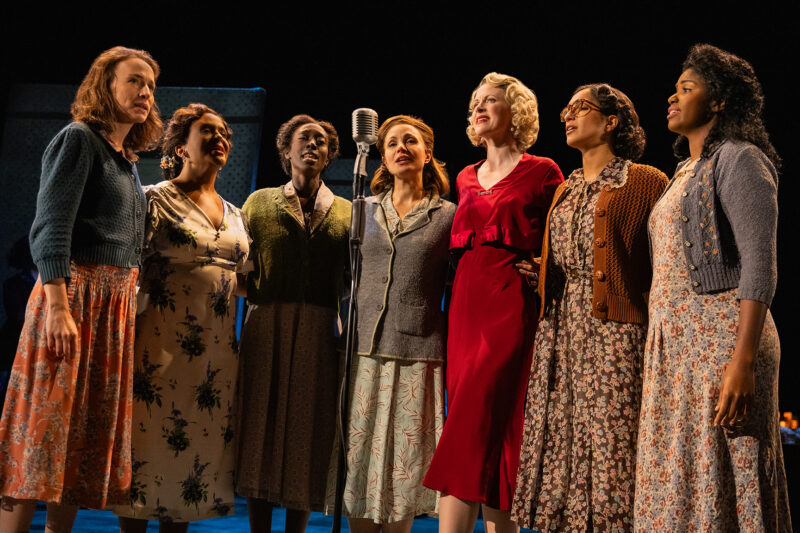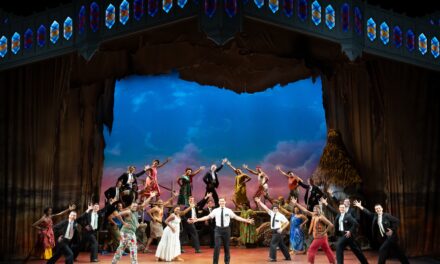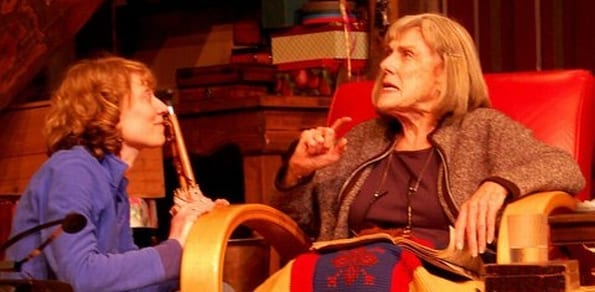SALT LAKE CITY –
I am always struck by the modern elegance of the beautiful Eccles Mainstage Theatre. I arrived for the current production, Girl From the North Country, knowing little more than that the musical incorporates Bob Dylan’s music. Which is why I was a bit surprised to find the auditorium filled with the sounds of jazz music from the 1930s. The music appears to emanate from an old wireless radio near the front of the stage. At center stage sits a full size upright bass on its side under a spotlight. Also lighted on stage is an old drum kit and an antique upright piano. All this emphasizes what is expected—that the focal point of the production will be the music.
The show is set in Duluth, MN in 1934, a few years before Bob Dylan would be born in the same town. As the show unfolded I found that the depression-era setting and characters find footing in the often desperate and heartfelt Dylan lyrics and melodies. With musicals crafted around pre-existing music, a cohesive plotline can be challenging. This is definitely true w
ith Girl from the North Country but writer and director Conor McPherson was up to the challenge. The script uses a boarding house as the hub that ties all the disparate characters and storylines together, a convention that mostly succeeds, though sometimes the loosely tied stories can be somewhat difficult to follow. Nonetheless, the story finds its way to some very touching moments, laced with desperation, sadness and loss, intermingled with occasional levity and hope.
Given that Girl from the North Country is a music-based show, it is also not surprising that the cast is packed with powerful vocalists. Of particular note is Mrs. Neilsen, played by Rayla Garske. Her solo numbers like Went to See the Gypsy and the final number, Pressing On showcase her voice extremely well. Nearly every actor is given a song or two to shine however, and it’s difficult to highlight the best of the best in this group. Elizabeth Laine, played by Kelly McCormick does an amazing and poignant rendition of Forever Young near the end of the show. Mr. Burke played by David Benoit, has a part in a duet rendition of Is Your Love In Vain that was striking as well, though in great part because his voice is less broadway belt, and more Bob Dylan than any of the
rest of the cast. Perhaps the most exhilarating vocal moment though, comes when Elias Burke, a young man that appears to be neurodivergent, played by Aidan Wharton, is suddenly freed from the constraints of his body and his soul seems to explode into a showstopping rendition of Duquesne Whistle. That song made me want to both weep and dance at once. One stand-out character, Reverend Marlowe, played by Jeremy Webb is worthy of his own call-out. Webb’s portrayal of the supposed reverend is as absolutely delightful as it is disturbing.
The set, designed by Rae Smith, uses scenic panels made of scrim material to great effect. When backlit, the panels become transparent and we see what is going on behind the “walls”, and when front lit, the panels are opaque walls. These panels seem to peel off as the show progresses, exposing deeper and deeper layers of the locale, mimicking the deeper and deeper layers of the characters exposed by the storylines. These panels, and lighting by Mark Henderson, together with McPherson’s tight and deliberate staging, facilitate visually captivating moments of silhouette where the ensemble can be seen in defined shadow behind a spotlit singer. This visual is particularly strong when the cast takes up percussive instruments to complement the musicians on stage. At times soloists are deliberately staged such that they are facing nearly or entirely upstage creating a feeling like we are voyeurs peaking into their innermost turmoil. The use of 1930s era microphones as part of the sound design by Simon Baker lends a vintage sound to some numbers. The targeted use of disco balls adds a surprisingly delightful touch—especially when, towards the end, two disco balls, hanging outside the proscenium are lit, casting a magical sparkly glow across the entire auditorium.
It’s difficult to decide whether to credit Music Director Timothy Splain, Director Conor McPherson or Movement director Lucy Hind for the beautiful visual and aural tableaus created throughout the production as the ensemble moves seamlessly from dialogue to backup vocals and percussion interwoven with choreographed movement. This collective choreography is simple, yet visually compelling and apropos to the feel of the production.
Make no mistake, Girl from the North Country is not your typical happily-ever-after sunshine-and-rainbows musical, and as such, may not appeal to all audiences—few characters achieve what you could say is a happy ending. But the interwoven stories are profound, evocative and tragically beautiful. So if you prefer poignancy to platitudes in your theatrical experience, or if you can adjust your expectations of happy endings, or if you just like Bob Dylan, then Girl from the North Country is well worth seeing.
The Girl from the North Country plays at The George S. and Dolores Eccles Theatre 131 Main Street Salt Lake City, UT June 11th – 16th, 2024. Tickets are available https://saltlakecity.broadway.com/.





